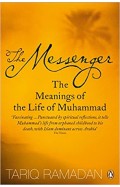The Vision Of Islam
By: Sachiko Murata, William Chittick
-
Rs 977.50
- Rs 1,150.00
- 15%
You save Rs 172.50.
Due to constant currency fluctuation, prices are subject to change with or without notice.
THE VISION OF ISLAM William C. Chittick/ Sachiko Murata Exploring the fundamental Muslim religious beliefs, this book covers the four dimensions of Islam as outlined in the Hadith of Gabriel: practice, faith, spirituality, and the Islamic view of history. Interweaving teachings from the Qur’an, the sayings of the Prophet, and the great authorities of the tradition, the authors introduce the essentials of each dimension, then go on to describe how each has been manifested in Islamic institutions through the course of history. The book tries to pry open the door to the Islamic universe and to the Muslim understanding of reality. It successfully finds Islam’s vision of itself within the Islamic intellectual tradition in general and the Sufi tradition in particular. Contents include: Islam; The Word Islam; The Five Pillars; Practice: The Historical Embodiment; The Koran and the Surma; Jurisprudence and Politics; Islam and Iman; The Three Principles: Tawhid, God, Shirk; The Signs of God; Divine Names; Essence and Attributes; Mercy and Wrath; Acts; The Unseen and the Visible; Heaven and Earth; Angels; Tight; Clay; Spirits and Bodies; Fire; Soul; The Measuring Out; Good and Evil; The Human Being; The Hierarchy of Creation; Prophet and Messenger; The Trust; The Fall; Guidance and Misguidance; Islam and Other Religions; The Return; Stages of Life and Death; This World and the Next; The Grave; The End; The Resurrection; Hell and Paradise; Final Judgment; The Intellectual Schools; Kalam; Theoretical Sufism; Philosophy; Ihsan; Love; Historical Manifestations of Ihsan; Art and Poetry; Practical Sufism; Islam in History; Islamic Interpretation of the Past; The Contemporary Situation.
THE VISION OF ISLAM William C. Chittick/ Sachiko Murata Exploring the fundamental Muslim religious beliefs, this book covers the four dimensions of Islam as outlined in the Hadith of Gabriel: practice, faith, spirituality, and the Islamic view of history. Interweaving teachings from the Qur’an, the sayings of the Prophet, and the great authorities of the tradition, the authors introduce the essentials of each dimension, then go on to describe how each has been manifested in Islamic institutions through the course of history. The book tries to pry open the door to the Islamic universe and to the Muslim understanding of reality. It successfully finds Islam’s vision of itself within the Islamic intellectual tradition in general and the Sufi tradition in particular. Contents include: Islam; The Word Islam; The Five Pillars; Practice: The Historical Embodiment; The Koran and the Surma; Jurisprudence and Politics; Islam and Iman; The Three Principles: Tawhid, God, Shirk; The Signs of God; Divine Names; Essence and Attributes; Mercy and Wrath; Acts; The Unseen and the Visible; Heaven and Earth; Angels; Tight; Clay; Spirits and Bodies; Fire; Soul; The Measuring Out; Good and Evil; The Human Being; The Hierarchy of Creation; Prophet and Messenger; The Trust; The Fall; Guidance and Misguidance; Islam and Other Religions; The Return; Stages of Life and Death; This World and the Next; The Grave; The End; The Resurrection; Hell and Paradise; Final Judgment; The Intellectual Schools; Kalam; Theoretical Sufism; Philosophy; Ihsan; Love; Historical Manifestations of Ihsan; Art and Poetry; Practical Sufism; Islam in History; Islamic Interpretation of the Past; The Contemporary Situation.
Zubin Mehta: A Musical Journey (An Authorized Biography)
By: VOID - Bakhtiar K. Dadabhoy
Rs 892.50 Rs 1,050.00 Ex Tax :Rs 892.50
All the Light We Cannot See: The Breathtaking World Wide Bestseller
By: Anthony Doerr
Rs 1,865.75 Rs 2,195.00 Ex Tax :Rs 1,865.75
Steve Jobs : The Exclusive Biography
By: Walter Isaacson
Rs 3,415.50 Rs 3,795.00 Ex Tax :Rs 3,415.50
The Silk Roads: A New History of the World
By: Peter Frankopan
Rs 3,865.50 Rs 4,295.00 Ex Tax :Rs 3,865.50
Sapiens A Brief History of Humankind
By: Yuval Noah Harari
Rs 2,630.75 Rs 3,095.00 Ex Tax :Rs 2,630.75
The Messenger: The Meanings of the Life of Muhammad
By: Tariq Ramadan
Rs 2,236.00 Rs 2,795.00 Ex Tax :Rs 2,236.00
Rumi :The Big Red Book The Great Masterpiece Celebrating Mystical Love And Friendship -
By: Coleman Barks
Rs 2,156.00 Rs 2,695.00 Ex Tax :Rs 2,156.00
Most Beautiful Names Of Allah
By: Samira Fayyad Khawaldeh
Rs 1,705.50 Rs 1,895.00 Ex Tax :Rs 1,705.50
All the Light We Cannot See: The Breathtaking World Wide Bestseller
By: Anthony Doerr
Rs 1,865.75 Rs 2,195.00 Ex Tax :Rs 1,865.75
Steve Jobs : The Exclusive Biography
By: Walter Isaacson
Rs 3,415.50 Rs 3,795.00 Ex Tax :Rs 3,415.50
The Silk Roads: A New History of the World
By: Peter Frankopan
Rs 3,865.50 Rs 4,295.00 Ex Tax :Rs 3,865.50
Sapiens A Brief History of Humankind
By: Yuval Noah Harari
Rs 2,630.75 Rs 3,095.00 Ex Tax :Rs 2,630.75
Season of Storms: A Novel of the Witcher
By: Andrzej Sapkowski
Rs 1,865.75 Rs 2,195.00 Ex Tax :Rs 1,865.75
Zubin Mehta: A Musical Journey (An Authorized Biography)
By: VOID - Bakhtiar K. Dadabhoy
Rs 892.50 Rs 1,050.00 Ex Tax :Rs 892.50
All the Light We Cannot See: The Breathtaking World Wide Bestseller
By: Anthony Doerr
Rs 1,865.75 Rs 2,195.00 Ex Tax :Rs 1,865.75
Steve Jobs : The Exclusive Biography
By: Walter Isaacson
Rs 3,415.50 Rs 3,795.00 Ex Tax :Rs 3,415.50
The Silk Roads: A New History of the World
By: Peter Frankopan
Rs 3,865.50 Rs 4,295.00 Ex Tax :Rs 3,865.50
Sapiens A Brief History of Humankind
By: Yuval Noah Harari
Rs 2,630.75 Rs 3,095.00 Ex Tax :Rs 2,630.75














-120x187.jpg?q6)




















-120x187.jpg?q6)

